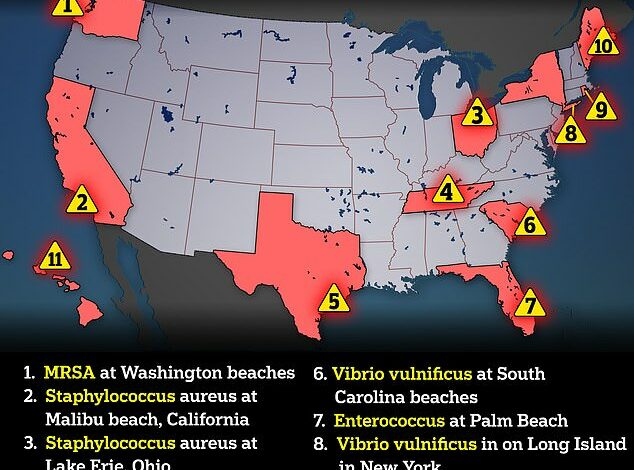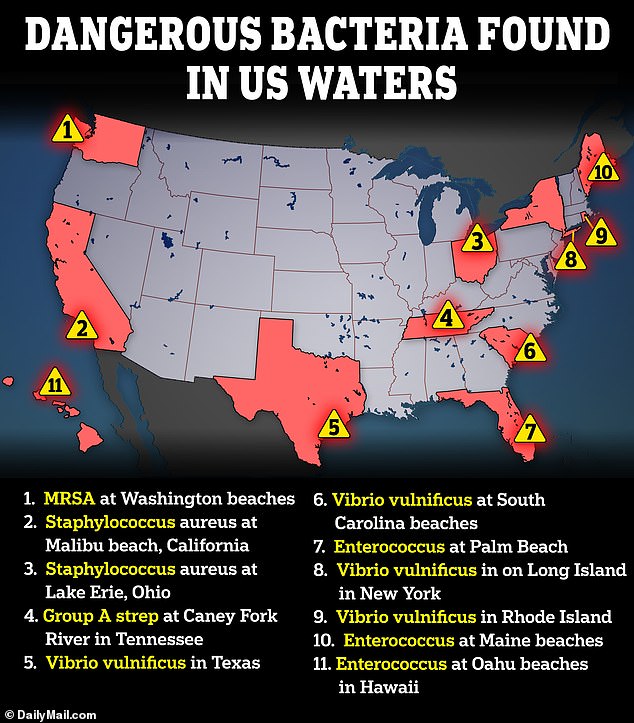Beachgoers are urged not to enter the water with open wounds, piercings or tattoos as a Rhode Island resident dies from a flesh-eating disease






Summer beachgoers in the US are on extra alert after another person died from a flesh-eating bacteria that lives in the water.
This week, a Rhode Island resident became the latest victim of vibrio vulnificus, the first death in the state since 2017.
His death followed the tragic passing of a Texas father who was wading through the water in flip-flops.
Vibriosis, the infection caused by vibrio, is fatal for about one in five patients, some within days.
In the most severe cases, the bacteria cause necrotizing fasciitis: they eat you from the inside out, rotting your flesh.

Dangerous bacteria that lurk in coastal waters, as well as rivers and lakes, are becoming more common with rising ocean temperatures. MRSA and enteroccus are some other examples of harmful bacteria.
Eating seafood containing the bacteria can also cause life-threatening sepsis, an immune response so strong that the body begins attacking its own cells.
The Rhode Island Department of Public Health has not yet responded to questions about which beach the resident visited or whether authorities have conducted testing in surrounding areas to show the bacteria is more widespread.
However, they are urging anyone with an open wound, new piercing or tattoo to stay away from the ocean, rivers and lakes this summer.
Vibrio thrives in warm seawater and the mix of fresh and salt water where rivers and oceans meet.
If the bacteria enter an open wound, it can enter the bloodstream.

Rhode Island’s beaches see about 10,000 visitors per day during the summer months, meaning thousands of people could be exposed to the bacteria in the water
Various enzymes and toxins are produced that break down proteins, fats and collagen, thus destroying skin and muscle tissue.
It does this by evading the body’s immune system and resisting the attempts of immune cells to destroy the immune system.
The bacteria cause an inflammatory response throughout the body, leading to further tissue damage.
The disrupted blood supply to the infected area worsens the damage, causing the tissue beneath the skin to die.
Dr. Jerry Larkin, director of the Rhode Island Health Department, said, “Although Vibrio is rare, it is important that anyone at risk take precautions when spending time in or around brackish or salt water during warm weather.
“Stay out of the water and take precautions if you have a cut or open wound, especially if you are at higher risk for serious illness.”

The maps above show projections of the future spread of Vibrio vulnificus, which is being fueled by rising ocean temperatures
People at high risk of serious infection include infants and young children whose immune systems are not fully developed. The elderly, people with underlying health conditions such as diabetes, kidney disease and liver disease, and pregnant people.
Vibrio sickened 11 people in just three states last summer: North Carolina, New York and Connecticut. The average age of the patients was 70. Ultimately, four people went into septic shock and five died.
All but one exposure was associated with exposure of wounds to natural water bodies.
Already this year, the Florida Department of Health has reported 28 cases of vibriosix of which were fatal.
Meanwhile in Texas, 33 cases have been identified on average every year, with most cases occurring between May and October.
Randy Bunch, 66, of Texas, contracted the bacteria after he went crab fishing in flip-flops last month. He had caught crabs in the shallow water of a boat ramp, a place he had visited many times before.

After Adam Perez dipped his toes in the water at a Corpus Christi park, his foot and leg swelled up and a giant blister formed, a result of vibriosis

Perez had been walking at Waters Edge Park in Corpus Christi and had dipped his toes in the water there
He died just a week later, with bruises and blisters up and down his leg. The nausea and flu-like symptoms caused inflammation all over his body. Blisters spread “like a fire” all over his body before he died.
Also in Texas in 2019, 42-year-old Adam Perez was hospitalized and lost most of the flesh on the lower half of his right leg after a dangerous dive at Waters Edge Park in Corpus Christi.
He had to undergo four different life-saving surgeries, including skin grafts on his mangled leg. This will never be the same again.
Some states, such as North Carolina, do not test their coastal waters for vibrio bacteria “because they naturally occur in coastal waters.”
North Carolina has 25 different beaches that are visited by millions of people each year.
The most recent Report 2018 Rhode Island officials reported an average of 13 cases per year, with a peak in cases in July.
Infections are typically rare in the Northeast, but public health officials warn they could become more common as global temperatures continue to rise. Warming oceans and lakes are making more land hospitable for harmful bacteria like Vibrio to thrive.
At the time of last year’s outbreak, which sickened 11 people, the CDC said, “Although the cases reported in July and August cannot be attributed solely to the heat waves, the relationship between the incidence of vibriosis and environmental conditions favorable to Vibrio growth, namely elevated water surface temperatures and low salinity, is well documented.”
People whose open wounds have come into contact with salt or brackish water should wash them thoroughly with soap and clean, running water.
The chance of dying from a wound infection varies from 15 to 30 percent.
If someone who has recently been exposed suddenly experiences severe abdominal pain, vomiting, diarrhea, high fever, rapid heart rate, low blood pressure, and/or a skin infection, they should see a doctor immediately. They may prescribe antibiotics.




